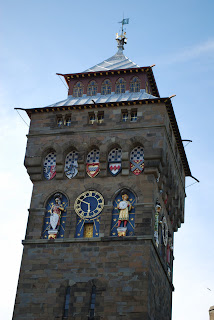“I travelled through England through France and through Spain”
pentangle
BRIDGEND
Went this morning to Bridgend, to see the stone circle there. I catch the train that leave there quite fast, and there I learn that the stone circle were close to the Recreational Center of the city. I could not imagine that it was actually inside it. And it is so integrated to it that there were people literally standing in it, as the rugby camp was a few meters from it.



Apparently is an important circle nowadays, as there are druid meetings there, as the two inscriptions in one of the stones say, one from 1947 and other in 1997. The circle resembles the one in Barry in size and in format. I counted 15 stones, including the one in the center (which looked like an altar with two steps). The position of the stones did not look very special or deliberate.
I’ve been wondering that a meaning for the stones circles could be the gathering of some sort of people, like chiefs or priests. There’s not a pattern in number of stones that can be followed, neither astronomical pattern. Lots of time they stand in sacred places, like burial mounds, but not always. We can only imagine that from time to time important people should get together to decide things, and this could be the place for it. I can only guess.
After leaving the stone circle, which actually was pretty and was a funny experience, I decided go and have a walk through the forest nearby. Walking through the forest is becoming almost an habit when I go after the ancient sites, because most of the times they are quite close to each other. This don’t mean that always been like this, because a lot have changed since two and half thousand years ago. Maybe the stone circles were connect with ancient urban centers. But we know that never we had so few forests, so we can imagine that they’ve been around.
CARDIFF MUSEUM


the Natural History Museum in Cardiff
Going back to Cardiff, it was a good time to go to the Museum of the City, where it was said to have a good collection. Apart from good temporary shows on photography (especially one of the British Council Collection called “no such thing as society” and another from Diane Arbus) they have a very nice collection on archeology, and it seems that they are very interested in it.
http://www.museumwales.ac.uk/
When I get to this area of the museum (which unfortunately was not allowed to take pictures, I had the luck to get invited for a guided tour (only me and a lady) by one of the specialists, that could not only show us the highlights of the collection, but talk very frankly and openly about the pieces and the history. I am not too much into guided tour, but this was the best.
This comes to relate with my studies about the races that been in Britain before the Romans (from the Neanderthals, the Cro Magnons, the traders from the East, the Iberians, the people from Central Europe, the Celtics amongst others).
I could see the oldest burial tomb from Europe, found in Wales 29.000 BC, called The Red Man, due to the red sand they would cover the body. I had ready about it, but see it with is quite exciting (ok, I find it exciting).
The old burial shells, trade as far as the Egypt, materials that traveled 2.000 kilometers, from the Alps to Wales, and could prove that the people would travel that much in ancient times. It all added information to me. In time I must write about it.
Leaving the Museum I just decided going to the Roman Castle, where I could finish my visit to Cardiff being into its main attractions.
CARDIFF CASTLE

the tower from the outside and the clock
the original Roman (and after Norman) castle

the entrance
the mix of diverse cultures in Cardiff
 corridor inside the castle
corridor inside the castle
The Cardiff Castle reminded me the one in St. Michael’s mount, as an old place that been taken by an wealthy family and centuries later was given or sold to the state. Its interior is astonishing. It’s been redecorated along the centuries, especially at the XIX.
the original Roman (and after Norman) castle

the entrance

the mix of diverse cultures in Cardiff
 corridor inside the castle
corridor inside the castle
the original walls can be seem at the bottom area
the "modern area"

yes, I got problems with books too

the arab room

 the decoration in the interior, from the 19th century
the decoration in the interior, from the 19th century
The old area of the castle, which is the Roman and later Norman one, is a round fortress in the top of a round mound, much like the ancient iron age forts that I’ve visited. I been wondering if it could be constructed upon such a place, but nothing could give me a hint.
the "modern area"

yes, I got problems with books too

the arab room

 the decoration in the interior, from the 19th century
the decoration in the interior, from the 19th centuryThey could only realized that this kind of construction is quite adequate for defensive porpouses and decided to use it.
Tomorrow I am planning go further into Wales, maybe to Pembroke or Swansea. It will depend on where I find place to stay, but I am more inclined to go to Pembroke.
Cheers.












Nenhum comentário:
Postar um comentário